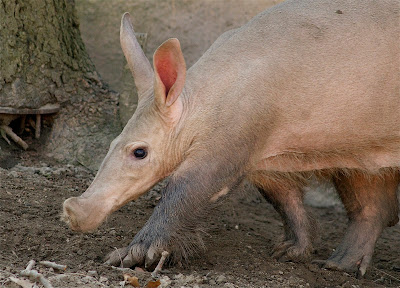 |
| Image: Valerie Orycteropus afer |
That's the thing about Aardvarks: each part of their body looks like it came from a completely different animal. Put them all together and you end up with a kind of Frankenstein's Mammal, a monstrous mish-mash of body parts wandering forlorn in search of love, happiness and its own humanity. Or in the case of the Aardvark, wandering confidently in search of food, perfectly at ease with itself and its body image.
 |
| Image: LinRu Photography |
There are six orders within the superorder Afrotheria - one for the elephants, another for dugongs and manatees, and then one each for hyraxes, elephant shrews, tenrecs and the Aardvark.
Afrotheria is so strange and diverse that it took DNA evidence in the 90's before everyone realised they were all one, big group.
 |
| Image: Steve Wilson |
Afrotheria has nothing so obvious, so when a hyrax looks like a rodent and a tenrec looks like a hedgehog or a shrew, it's easy to be fooled. But then you get confronted by dugongs and elephants and Aardvarks, which don't look much like anything.
You might know that elephants and their Proboscidean relatives once roamed across almost the entire world and there were mighty mammoths and weird things with tusks coming out of their lower jaw. They're all gone now, leaving just two, endangered species.
 |
| Image: Richard Stockwell |
The word "Aardvark" comes from the Afrikaans for "earth pig". It's a good thing the English-speaking world just took that word and put it right at the front of our encyclopaedias or we'd all be asking how the earth pig is related to the groundhog. I suppose the answer would be that they both dig. That's all.
 |
| Image: Nano Maus We'll need a blowtorch for those nails! |
Being nocturnal, Aardvarks spend their day sheltering from the heat, fast asleep in a cool, underground burrow. They emerge at night, ears alert to the sound of danger, nose twitching at the scent of food.
 |
| Image: Xenocryst @ Antares Scorpii |
Sealing its nostrils shut to keep out the dust, the Aardvark uses a thin, 30 cm (one foot) long tongue to slurp up as many as 50,000 termites a night. Thick skin provides protection from the stinging bites of infuriated soldiers and all the while those big ears seek out the sound of predators that may lurk nearby.
Video: WCSMedia
If you know anything about Anteaters or Pangolins it would come as no surprise to learn that Aardvarks have no teeth, after all what's the use if you eat nothing but tiny ants and termites all day? In fact, questions would be raised if Aardvarks did have teeth.
Aardvarks DO have teeth! So consider the question raised.
 |
| Image: Phil Myers Aardvark teeth! Each one is made of over 1,000 columns of dentine. That's why they're in an order called Tubulidentata |
Probably they're best left to the Aardvark.
The strange thing about Aardvark Cucumbers is that while they start off above ground, the vines soon turn downward and plunge into the earth. The fruits come to maturity a good 15 to 30 cm (6 inches to a foot) underground. Aardvarks dig them up and eat them - it's their main source of water - and then the seeds pass all the way through to the other side and begin to grow in their own little dollop of manure.
 |
| Image: Opencage |
Interestingly enough, young Aardvarks actually start off with a full set of teeth! After a gestation period of about 7 months, mother Aardvark gives birth to one youngster in an especially spacious burrow she excavates for herself. In just two weeks, baby Aardvark is able to follow its mother on her night-time foraging expeditions. At about 3 months of age it will begin to eat termites and at 6 months it can dig its own burrow.
Video: Brookfield Zoo
Somewhere along the way the infant Aardvark goes through some kind of un-teething process, where it loses the less useful teeth. They look something like a Naked Mole Rat at this tender age. It's a look they'll never completely shake off.

5 comments:
Thanks for the articles on Aardvarks, in our country in southern India, we call this animal as "Bijju". these bijjus live in old and shadowy (Cemetry)Graveyards where there is plenty of cool and shadowy trees and lush green grass and lots of ants and termites to feed.
Now I know from your article, why the Bijjus were living in graveyard(Cemetry), now I understand fully, they eat the termites and ants, but we in india were thinking that they were digging to eat the corpses.
Thanks for the Article my friend.
even their name is unique and fun to say. :)
@Ishrat: No problem! Wouldn't it be strange if it turned out that the ants and termites were the ones digging to eat the corpses? They probably weren't, but it's interesting that people almost never suspect the tiny insects!
@TexWisGirl: Yes! And they're always right at the front of the dictionary!
Ha! My favourite animal of all animals!
Fun fact, the German name for the aardvark is "Erdferkel", wich means literally earth-piglet, so the cute bugger in the video is an "Erdferkelferkel". ;)
Oh, and that's not a problem, regarding the groundhog, as we call it "Murmeltier", literally "mumbling animal"...
Anyway, my sincere thanks for that video!
Did I mention that I like aardvarks? ;)
Sounds like you like Aardvarks! "Erdferkelferkel" sounds hilarious, a very fun word to say. "Mumbling animal"... interesting. Strange, but interesting!
Post a Comment